|

Just the Facts: These birds have thin, pointed wings, which allow them to dive at extremely high speeds. Peregrine Falcons, the fastest birds on Earth, are said to have reached stoop speeds of up to 200 mph. The falcons are part of the family Falconidae, which also includes the caracaras, Laughing Falcon, forest falcons, and falconets.
 Other falcons include the Gyrfalcon, Lanner Falcon, and the Merlin. Some small insectivorous falcons with long, narrow wings are called hobbies, and some which hover as they hunt for small rodents are named kestrels. The traditional term for a male falcon is a "tiercel". It is so called, from Latin tertius, because it is roughly a third smaller than the female. Other falcons include the Gyrfalcon, Lanner Falcon, and the Merlin. Some small insectivorous falcons with long, narrow wings are called hobbies, and some which hover as they hunt for small rodents are named kestrels. The traditional term for a male falcon is a "tiercel". It is so called, from Latin tertius, because it is roughly a third smaller than the female.
Brains and Beauty: In February 2005 the Canadian scientist Dr Louis Lefebvre announced a method of measuring avian IQ in terms of their innovation in feeding habits. Falcons were named among the most intelligent birds based on this scale.
Old as the Hills: Falcon fossils have been found dated 50 million years ago in the Eocene in the Messel Pit in Germany.
-----------------------------------------------------------------------------------------------------------------------------
Peregrine Falcon:
The Peregrine Falcon is the fastest creature on the planet in its hunting method, the stoop, in which it soars to a great height, then free falls at speeds in excess of 420 km/h (260mph) into either wing of its prey, as not to harm itself on impact.

Weights and Measures:
The Peregrine Falcon (Falco peregrinus), sometimes formerly known in North America as Duck Hawk, is a medium-sized falcon about the size of a large crow: 38-53 cm (15 to 21 inches) long. The English and scientific species names mean "wandering falcon," and refer to the fact that some populations are migratory. It has a wingspan of about 1 metre (40 inches). Males weigh 570-710 grams; the noticeably larger females weigh 910-1190 grams.

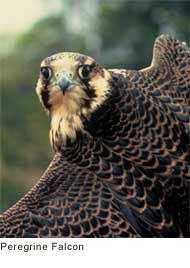 Range: Peregrine Falcons live mostly along mountain ranges, river valleys, and Range: Peregrine Falcons live mostly along mountain ranges, river valleys, and
coastlines and increasingly, in cities. They are widespread throughout the entire world and
are found on all continents except Antarctica.
Migration: Peregrines in mild-winter regions
are usually permanent residents, and some
birds, especially adult males, will remain on the breeding territory. However, the Arctic subspecies migrate; tundrius birds from Alaska, northern Canada and Greenland migrate to Central and South America, and all calidus birds from northern Eurasia move further south or to coasts in winter.
Diet: Peregrine Falcons feed almost exclusively on birds, such as doves, waterfowl and songbirds, but occasionally they hunt small mammals, including bats, rats, voles and rabbits. Insects and reptiles make up a relatively small proportion of their diet. On the other hand, a growing number of city-dwelling Falcons find that feral pigeons and Common Starlings provide plenty of food.
They Eat and Sleep Eating: Because of their high metabolic rates, Peregrine Falcons must consume more food in proportion to their size than most animals. To be efficient flyers, the digestive system of birds has to be both as light as possible and as efficient as possible. The need to keep weight as low as possible also means that, except perhaps prior to migration, there is a limit to the amount of fat the Peregrine Falcon can store.
Take a Breather:
The respiratory system is also unique; the Peregrine Falcon maintains a one-way flow of air so that it can breathe while flying. This system is much more efficient than the more common two-way flow of air. Birds have two relatively small lungs, where gas exchange occurs, but the lungs are augmented by bellows-like air sacs, where no gas exchange occurs. These air sacs keep the lungs perpetually inflated, even when the bird is exhaling. The Peregrine Falcon also has cones in its nostrils to help regulate breathing at high speeds. Its circulatory system also needs to be exceptionally strong, because flying takes lots of oxygen. A bird's heart beats much faster than the human heart does, approximately 600-900 beats per minute.
Life-span: The average life span of a Peregrine Falcon is approximately eight to ten years, although some have been recorded to live until slightly more than twenty years of age.

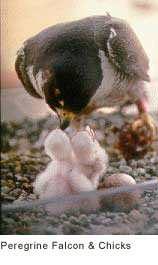 Nests and Nestlings:
Peregrine Falcons breed at approximately two to three years of age. They mate for life and return to the same nesting spot annually. Their courtship flight includes a mix of aerial acrobatics, precise spirals, and steep dives. Nests and Nestlings:
Peregrine Falcons breed at approximately two to three years of age. They mate for life and return to the same nesting spot annually. Their courtship flight includes a mix of aerial acrobatics, precise spirals, and steep dives.
Females lay an average clutch of three to four eggs in a scrape, normally on cliff edges or, increasingly, on tall buildings or bridges. They occasionally nest in tree hollows or in the disused nest of other large birds. The laying date varies according to locality, but is generally from February to March. The females incubate the eggs for twenty-nine to thirty-two days at which point the eggs hatch.
Nuclear Family: Thirty-five to forty-two days after hatching, the chicks will fledge, but they tend to remain dependent on their parents for a further two months. The tercel, or male provides most of the food for himself, the female, and the chicks; the falcon, or female stays and watches the young.

Threats: The Peregrine Falcon became endangered because of the overuse of pesticides, during the 1950s and 1960s. Pesticide build-up interfered with reproduction, thinning eggshells and severely restricting the ability of birds to reproduce. The DDT buildup in the falcon's fat tissues would result in less calcium in the eggshells, leading to flimsier, more fragile eggs. In several parts of the world, this species was wiped out by pesticides.
Peregrine eggs and chicks are often targeted by thieves and collectors, so the location of their nest should not be revealed, unless they are protected.
Recovery Efforts: Wildlife services around the world organized Peregrine Falcon recovery teams to breed them in captivity. The birds were fed through a chute so they could not see the human trainers. Then, when they were old enough, the box was opened. This allowed the bird to test its wings. As the bird got stronger, the food was reduced because the bird could hunt its own food. This procedure is called hacking. To release a captive-bred falcon, the bird was placed in a special box at the top of a tower or cliff ledge.
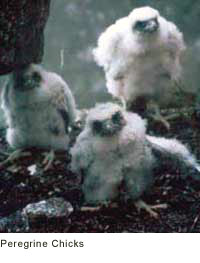 Success! Worldwide recovery efforts have been remarkably successful. In the United States, the banning of DDT eventually allowed released birds to breed successfully. There Success! Worldwide recovery efforts have been remarkably successful. In the United States, the banning of DDT eventually allowed released birds to breed successfully. There
are now dozens of breeding pairs of Peregrine Falcons in the northeastern USA and Canada.
City Birds: Many have settled in large cities, including London Ontario and Derby, where they nest on cathedrals, skyscraper window ledges and the towers of suspension bridges. About 18 pairs nested in New York City in 2005. These structures typically closely resemble the natural cliff ledges which the species prefers for nesting locations. During daytime the falcons have been observed swooping down to catch common city birds such as pigeons and Common Starlings. In many cities, the Falcons have been credited with controlling the numbers of such birds, which have often become pests, without resort to more controversial methods such as poisoning or hunting.
Nesting Boxes: In Virginia, state officials working with students from the Center for Conservation Biology of the College of William and Mary in Williamsburg successfully established nesting boxes high atop the George P. Coleman Memorial Bridge on the York River, the Benjamin Harrison Memorial Bridge and Varina-Enon Bridge on the James River, and at other similar locations. Thirteen new chicks were hatched in this Virginia program during a recent year. Over 250 falcons have been released through the Virginia program.
In the 53-mile long New River Gorge of West Virginia, another program is underway to re-establish populations by transferring "bridge chicks" from Virginia, Maryland, and New Jersey to special nesting boxes mounted on the high cliffs. Chicago also started its habitat protection programs with a special recognition of Peregrine Falcon by making it the official bird of the city.
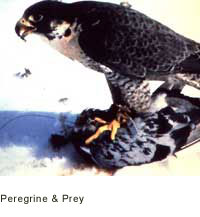 Unlisted: The Peregrine Falcon was removed from the U.S. Threatened and Endangered Species list on August 25, 1999. In 2003, some states began issuing limited numbers of falconry permits for Peregrines due to the success of the Unlisted: The Peregrine Falcon was removed from the U.S. Threatened and Endangered Species list on August 25, 1999. In 2003, some states began issuing limited numbers of falconry permits for Peregrines due to the success of the
recovery program.
In the UK, there has been a good recovery of populations since the crash of the 1960s.
This has been greatly assisted by conservation and protection work led by the RSPB. Peregrines now breed in many mountainous and coastal areas, especially in the west and north. They are also using
some city buildings for nesting, capitalizing
on the urban pigeon populations for food.
Trivia:
The Mediterranean Peregrine Falcon, in this context known as the Maltese Falcon, was the annual rent required by Holy Roman Emperor Charles V when he donated the Island of Malta to the Knights Hospitaller in 1530.
The Peregrine Falcon appears on the left hand side of the Coat of arms of the Isle of Man. The Peregrine is used owing to the historical importance of the bird in the Isle of Man's. When Henry IV of England gave the Isle of Man to Sir John Stanley he made the condition that Sir John give two Peregrine Falcons to him, and furthermore to every future monarch of England on his or her Coronation Day. This tradition was carried out up to the Coronation of George IV in 1821.
The Peregrine Falcon has cones in its nostrils to help regulate breathing at high speed, and, once their use had been found, they were mimicked in fighter jets.
A Peregrine Falcon, Lucy, was filmed in the movie The Falcon and the Snowman.
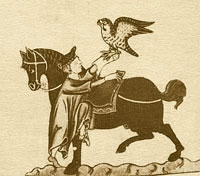 In the series of children's novels, "Animorphs," the peregrine falcon is the favorite bird morph of Jake Berenson. In the series of children's novels, "Animorphs," the peregrine falcon is the favorite bird morph of Jake Berenson.
A Peregrine Falcon will be prominently featured on the Idaho quarter to be issued in 2007 as part of the United States Mint's 50 State Quarters program.
Unlike Peregrine Falcons of the Northern Hemisphere, Australian Peregrine Falcons are non-migratory. Also, the breeding season of the Australian Peregrine Falcons lasts from July to November each year.
Sub-species of Peregrine Falcon:
There are many subspecies of Peregrine Falcon, including...
--Falco peregrinus, the nominate mainly non-migratory race, which breeds over much of western Eurasia
--F.p. anatum is mostly found in the Rocky Mountains. Although it used to be common throughout eastern North America, and is currently being re-introduced in the region, it remains uncommon in much of its former range. Most mature anatums, except those that breed in more northern areas, winter in their breeding range. It is a rare vagrant to western Europe
--F. p. brookei of southern Europe to the Caucasus is smaller and more rufous below that the nominate race.
--F. p. calidus breeds in the Arctic tundra of Eurasia and is completely migratory and travels as far as sub-Saharan Africa. It is larger and paler than the nominate race
--F. p. madens breeds in the Cape Verde Islands and has brown-washed upperparts.
--F.p. pealei is found in the Pacific Northwest of North America, and is non-migratory.
--F. p. tundrius breeds in the Arctic tundra of North America but is migratory and travels as far as South America.
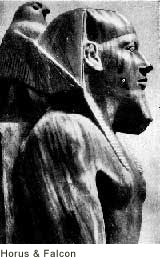 Species of Falcon: Species of Falcon:
* African Hobby, Falco cuvierii
* American Kestrel, Falco sparverius
* Amur Falcon, Falco amurensis
* Aplomado Falcon, Falco femoralis
* Australian Hobby, Falco longipennis
* Bat Falcon, Falco rufigularis
* Banded Kestrel, Falco zoniventris
* Barbary Falcon, Falco (peregrinus) pelegrinoides
* Black Falcon, Falco subniger
* Brown Falcon, Falco berigora
* Common Kestrel, Falco tinnunculus
* Dickinson's Kestrel, Falco dickinsoni
* Eleonora's Falcon, Falco eleonorae
* Eurasian Hobby, Falco subbuteo
* Fox Kestrel, Falco alopex
* Greater Kestrel, Falco rupicoloides
* Grey Kestrel, Falco ardosiaceus
* Grey Falcon, Falco hypoleucos
* Gyr Falcon, Falco rusticolus
* Laggar Falcon, Falco jugger
* Lanner Falcon, Falco biarmicus
* Lesser Kestrel, Falco naumanni
* Madagascar Kestrel, Falco newtoni
* Mauritius Kestrel, Falco punctatus
* Merlin Falcon, Falco columbarius
* Nankeen Kestrel, Falco cenchroides
* New Zealand Falcon, Falco novaeseelandiae
* Orange-breasted Falcon, Falco deiroleucus
* Oriental Hobby, Falco severus
* Peregrine Falcon, Falco peregrinus
* Prairie Falcon, Falco mexicanus
* Red-footed Falcon, Falco vespertinus
* Red-necked Falcon, Falco chicquera
* Saker Falcon, Falco cherrug
* Seychelles Kestrel, Falco araea
* Sooty Falcon, Falco concolor
* Spotted Kestrel, Falco moluccensis
* Taita Falcon, Falco fasciinucha
* Réunion Kestrel, Falco buboisi (extinct)
All text is available under the terms
of the GNU Free Documentation License
|